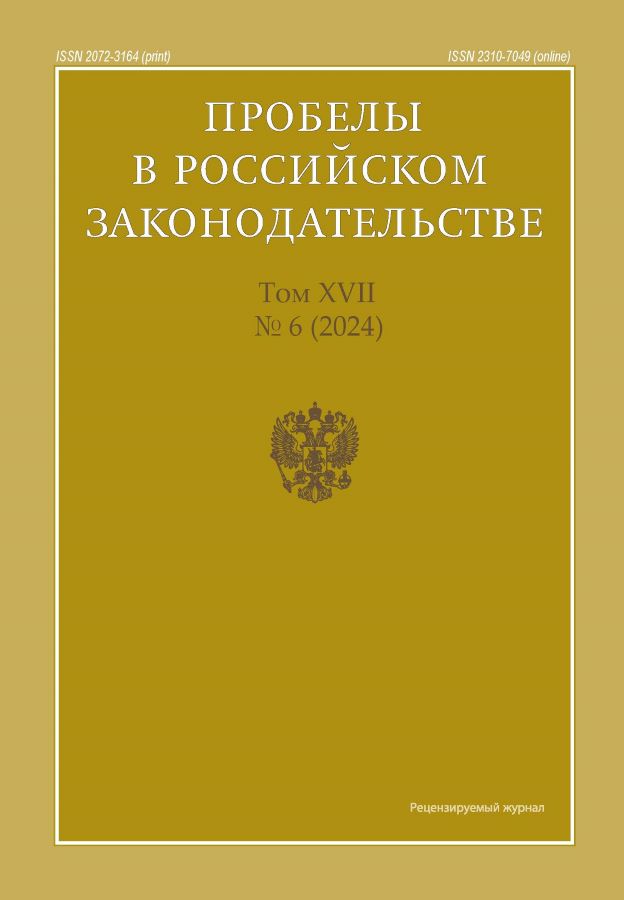Application of the classification of types of things to human organs and tissues
- Authors: Byzov A.A.1
-
Affiliations:
- Kutafin Moscow State Law University
- Issue: Vol 17, No 6 (2024)
- Pages: 87-92
- Section: Private Law (Civil) Sciences
- URL: https://journals.eco-vector.com/2072-3164/article/view/650766
- DOI: https://doi.org/10.33693/2072-3164-2024-17-6-087-092
- EDN: https://elibrary.ru/HOGSIM
- ID: 650766
Cite item
Abstract
With the development of biotechnology, the possibility of human organs and tissues acting as objects of various legal relations becomes obvious: compensated or gratuitous alienation, exchange, etc. However, at present there is no single position regarding the legal nature of human biomaterials. The most popular solution is to recognize organs and tissues as things limited in circulation. However, it is possible to note the lack of sufficient argumentation of the grounds for limiting circulation and the list of types of things to which biomaterials belong. As a result, it is impossible to determine the characteristics of body parts as objects and to form their legal regime. The published work provides a detailed analysis of various approaches to the features of things, created through the study of the works of scientists on this issue using various methods of scientific knowledge (analysis, synthesis, induction, deduction, comparative legal and others). As a result, the author's approach to the features of divisible, indivisible, individually defined, consumable, non-consumable, withdrawn and limited in circulation things is formed. Further, based on the examination of the presence of characteristics in organs and tissues, their classification as divisible or indivisible (depending on the type), unique and individually defined, consumable or non-consumable (depending on the method of use) and limited in circulation items is argued.
Full Text
About the authors
Andrey A. Byzov
Kutafin Moscow State Law University
Author for correspondence.
Email: byzov.andrey2012@yandex.ru
SPIN-code: 9831-5886
postgraduate student, Institute of Private Law, Department of Civil Law
Russian Federation, MoscowReferences
- Apolinskaya N.V. Human biological objects in the civil law of the Russian Federation: abstract of dis. ... candidate of legal sciences: 12.00.03; [Place of protection: Far Eastern state University]. - Irkutsk, 2009.
- Grishaev S.P. Evolution of legislation on objects of civil rights Specially for the "GARANTEE" system, 2015.
- Evseev E.F. Legal status of the human body and its parts // Advocate. 2010. N 6. pp. 34 - 40.
- Maifat A.V., Lisachenko A.B. The human body, its individual parts as objects of legal impact (some proposals for discussion) // Legal world. 2002. N 2. pp. 4 - 15.
- Maliarova N.A. Classification of things in civil law: Forum of young scientists. 2020. No. 1 (41).
- Mokhov A.A., Melikhov A.V. Cells as an object of civil and other legal relations // Medical law. 2008. N 2. P. 38.
- Myzrov S.N., Nagorny V.A. On the issue of the property-legal status of human organs and tissues // a differentiated approach to resolving the problem: Medical law. 03.24. 2014. N 3. P. 35 - 40.
- Novoselova L.A. Disposal of the human body: civil law aspect // Law. 2021. N 8. P.115-130.
- Pobedonostsev K. P., Course in Civil Law - Moscow// Statut, 2003.P. 620.
- Serebryakova A., Aramaskin M., Varyushin M. State and legal regulation of the use of human organs and tissues for transplantation purposes as special objects of civil law (comparativistic study)// Power. 2011. N 8. P. 155 - 157.
- Trubina V. A. Human tissues and organs as objects of civil rights: monograph // OOO Infotropic Media, 2020. P. 8-10.
Supplementary files









